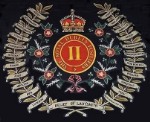Spanish Armed Forces of the Campo (1880s)
[Molly Bloom, thinking of Gibraltar.] "... the first time I saw the Spanish cavalry at La Roque it was lovely ..."
n/ Ulysses (Gabler) 18:398-99.
Teenaged Marion Tweedy couldn't have seen Spanish cavalry, or any other Spanish Army formation, at San Roque. In May 1815, the government transferred permanently the army HQ for the Campo de Gibraltar from San Roque to Algeciras. In 1823, town officials asked the government to return troops to San Roque, but their request was denied.
In the 1880s, there were two barracks in San Roque: Plaza de Caballos (cavalry) for 50 men and 44 horses; Barracones (infantry) for 150 men. Barracones was vacant and Plaza de Caballos was headquarters for a mounted customs police (Carabineros) squadron. Joyce thought there was cavalry at San Roque as Field's guidebook to Gibraltar states, incorrectly, that the Spaniards kept "... a regiment of cavalry at San Roque, and one of infantry at Algeciras."
n/ Adolfo Munoz Perez, "San Roque y su Historia Militar: (1704-1900)," Almoraima 17 (1996): 206-18; Camilo Valles, "Gibraltar and the Bay of Algeciras," United Service Magazine (November 1902); Cuerpo de Estado Mayor del Ejercito, La Organizacion Militar de Espana en 1871 (Madrid: Deposito de la Guerra, 1873); Henry Field, Gibraltar (London: Chapman & Hall, 1889), 70.
Spanish Uniformed Presence Near Gibraltar
During the time young Marion Tweedy was in Gibraltar, there was little Spanish military presence in the countryside of Gibraltar. The only garrison was at the town of Algeciras and it totaled 430 men, all ranks. Two para-military forces had complements near Gibraltar: The Cuerpo de Carabineros and the Guardia Civil. The Carabineros was Spain's border guard and customs inspectorate; the Guardia Civil was the rural constabulary, which was more like the French Gendarmarie National than the Royal Irish Constabulary.
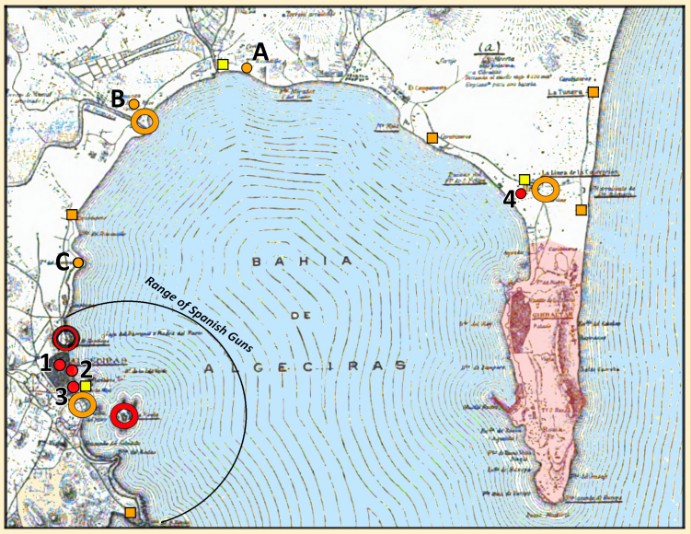
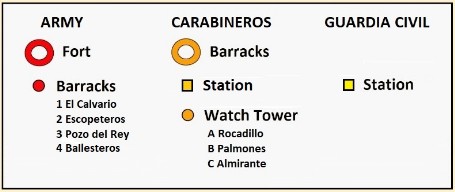
Spanish Army, 1850-1890
By the middle of the nineteenth century, Spain was no longer a European military power. Its army was poorly trained and equipped, badly paid, and had few career soldiers. Few young Spanish men joined the army so the rank and file was almost exclusively composed of conscripts. Each year about 40% of twenty-year-old males were compelled to serve in Spain for two or three years, or abroad for four years. Infantry conscripts for home service spent two years with the active army followed by four years on unpaid furlough. Afterwards, they were on the reserve list for six years. Infantry conscripts in the colonial forces served four years full-time followed by four years on the reserve list. Only the poor were conscripted as one could purchase an exemption from home service for £60; foreign service for £80.
The prestige arms of the Spanish military were the artillery and engineers. The best conscripts were assigned to those branches which were officered by men of moneyed families. Young men of socially prominent families that lacked money officered the infantry and cavalry. Unlike in the British Army, many infantry and cavalry officers were commissioned from the ranks. To provide employment for young men of social standing who lacked incomes, the government over-officered the army. This was done primarily by providing full officer complements as cadres for reserve units. For example, a reserve infantry battalion had serving full-time a lieutenant-colonel, three majors, four captains, and fourteen lieutenants. In 1883, commissioned officers accounted for 11.1% of the Home Army of 120,500 men, all ranks. For the Colonial Army, officers made up only 5.3% of that 40,000-man force.
As shown below, the Spanish soldier was poorly paid. In that his free ration was bread only, privates spent three-fourth's of their pay on food. Sergeants, who were career soldiers, received half the pay of their British counterparts. Note that Spanish officers serving full-time with depots or reserve formations had almost no duties and accordingly, were paid at 80% of the regular rate. For example, a captain serving with a reserve battalion received £96 annually; a captain with an active battalion £120.
1883 Comparative Remuneration, Spain v. UK
Spanish Army, Infantry | British Army, Infantry | |||
Rank | £ per Annum | Other, Per Diem | £ per Annum | Other, Per Diem |
Lieut.-Colonel | 173/216 | Family Quarters | 328 | |
Major | 154/192 | Family Quarters | 292 | |
Captain | 96/120 | Family Quarters | 211 | |
First Lieutenant | 72/90 | Family Quarters | 119 | |
| Sgt.-Maj. (Colour-Sgt.) | 27 | Family Quarters 1.5 lbs. bread | 55 | Family Quarters 1 lb. bread + .5 lb. meat |
Sergeant | 22 | Family Quarters 1.5 lbs. bread | 43 | Family Quarters 1 lb. bread + .5 lb. meat |
| Corporal - 1st (Corporal) | 14 | 1.5 lbs. bread | 30 | 1 lb. bread + .5 lb. meat + 1.5d. cookhouse contribution |
| Corporal - 2nd (Lance Cpl.) | 12 | 1.5 lbs. bread | 23 | 1 lb. bread + .5 lb. meat + 1.5d. cookhouse contribution |
Private | 11 | 1.5 lbs. bread | 18 | 1 lb. bread + .5 lb. meat + 1.5d. cookhouse contribution |
(British Army equivalent ranks in parentheses)
Note that the British Army purchased .75 lb. of "meat" per man but regulations allowed for 30% bone. Accordingly, each soldier received about .50 lb. of actual meat. Also, in the 1880s, the state contributed to each cookhouse 1.5d. per man daily; the soldiers paid 3d. Sergeants did not receive this small benefit as they ate in their mess and did not receive cookhouse food. The sergeants' mess; however, received the bread and meat ration.
n/ War Office: The Armed Strength of Spain, Royal Warrant for the Pay of the Army, 1881.
The Algeciras Garrison
In the early 1880s, the only Spanish Army units near Gibraltar were those stationed in Algeciras. They were quartered in the town's three barracks and two forts, one of which was on a small island one kilometer southeast of the town's harbor. In 1883, army components in Algeciras were as follows:
HQ | Campo de Gibraltar | 5 Officers |
Garrison Staff | Algeciras | 5 Officers |
Infantry Depot & Reserve Cadre | Depot 2/9th (Soria) Regiment & 36th Reserve Battalion. | 37 Officers 4 NCOs 8 Rank & File 25 Recruits |
Engineer Field Company | Component of the 3rd Engineer Regiment. | 4 Officers 7 NCOs 80 Rank & File |
Engineer Telegraph Section | Component of the 5th Engineer Regiment. | 1 Officer 4 NCOs 12 Rank & File |
Battalion HQ, Fortress Artillery | 2/2nd Fortress Artillery Regiment | 5 Officers 2 Rank & File |
Two Fortress Artillery Companies | Components of the above battalion. | 8 Officers 8 NCOs 202 Rank & File |
Class 3 Hospital | 3 Medical Doctors 2 Surgical Techs 1 Pharmacist 2 NCOs 14 Rank & File |
The depot and reserve cadres provided basic training for recruits and maintained the reserve lists. Spanish infantry basic training was for only 6 weeks while in most European armies, including the British, it lasted 13 weeks. As reservists rarely trained, the reserve staff had few duties. The Algeciras Military Sub-District was home to about 1,200 infantry reservists.
Algeciras was headquarters for the 2nd Battalion, 2nd Fortress Artillery Regiment. Two of the battalion's companies were in Algeciras, the other two in Tarifa.
Military engineers in town consisted of a field company of the 3rd Engineer Regiment and a telegraph section of the 2nd Battalion, 5th Engineer Regiment. Algeciras had army telegraphers and engineers as the town had the European land station for the military submarine telegraph cable to Ceuta in North Africa.
The Algeciras Military Hospital was the only such facility in southern part of Cadiz Province. The hospital's service area ran along the coast from Barbate (55 kilometers to the west) to the outskirts of Marbella, Malaga Province (70 kilometers to the northeast). Note that the Daughters of Charity of St. Vincent de Paul provided the Spanish Army with trained nurses. Red Cross volunteers also worked in military hospitals.
Total uniformed strength of the Algeciras Garrison was a permanent party of 404, all ranks, plus about 25 recruits and the hospital patients. Though the Comandancia General del Campo de Gibraltar was of negligible military strength (725 troops including HQ and the Tarifa Garrison), it was commanded by a major-general who was de facto civil governor of the area as well as its chief public health officer. As the Campo was a military zone, its commander had operational authority over the 600 paramilitary troops stationed in the area (Carabineros and Guardia Civil). Note that the original Campo de Gibraltar of the early eighteenth century was the area surrounding the bay, extending north to San Roque. By the 1880s, this military zone had grown to encompass one-fourth the territory of Cadiz Province. (Click here and a map of Cadiz will open from this website in a popup window.)
n/ La Organizacion Militar de Espana en 1871; War Office, The Armed Strength of Spain (London: HMSO, 1883); Ministerio de la Guerra, Anuario Militar de Espana, 1892; C.J. L'Estrange, "The Spanish Army," The Illustrated Naval and Military Magazine 46, No. 8 (April 2, 1888): 257-71; Antonio de Pablo Cantero, "La Infanteria de Reserva," in Milicia y Sociedad en la Baja Andalucia, Ignaciio Marin Marina, ed. (Seville: Catedra General Castanos, 1999): 327-50; Maria Angeles Infante, "The Daughters of Charity in the History of Military Health Care," Anales 12, No. 4 (July-August 2015): 237-43; F.J. Martinez Antonio, "Public Health and Empire in Isabellin Spain (1833-68)," Historia, Ciencias, Saude-Manguinhos 13, No. 2 (April-June 2006): 139-73.
The Barracks
There were three barracks in town; El Calvario (infantry), Escopeteros (artillery/engineer), and Pozo del Rey (cavalry). There was also a 180-bed, district military hospital. Peacetime accommodation capacity was as follows: El Calvario 280, Escopeteros 220, Pozo del Rey 67 + 68 horses.
n/ O'Shea's Guide to Spain and Portugal, 7th Ed. (Edinburgh: Black, 1885), s.v. "Algeciras;" La Organizacion Militar de Espana en 1871.
Fort Santiago
Built in the 1830s, this was the last Spanish-built fortification in Algeciras. Located just north of town, it initially housed 60 men. In the 1860s it was armed with six 150mm guns, two 101mm howitzers, and one 178mm howitzer. When Molly was in Gibraltar, the fort had two 130mm guns and two 150mm guns, all Spanish-made smooth-bores.
Henry George O'Shea, in his Guide to Spain and Portugal writes of this fort as follows: "The pasteboard fort and few guns which we see are only a useless show." At the time, the army found the facility fit to quarter only 23 men.
In the early twentieth century, the government added multiple barrack houses to the fort. The site is now occupied by housing.
n/ Valles, "Gibraltar and the Bay of Algeciras;" Angel J. Saez Rodriguez and Oscar Saez Rodriguez, "Santiago, el Ultimo Fuerte de Algeciras," Almoraima 33 (2006): 171-82; O'Shea's Guide to Spain and Portugal, s.v. "Algeciras."

Original Structures of Fort Santiago, 1929
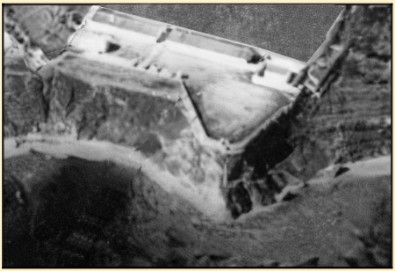
Fort San Fernando
The Spanish built this fort in 1734 and improved it in 1745 and again in the 1850s. It had three firing batteries and could accommodate 20 guns. In the 1880s, like Fort Santiago, its armament was obsolescent, smooth-bore artillery pieces. It had Spanish-made 130mm and 150mm guns and German-made Krupp 210mm howitzers. It also had Napoleonic War era 305mm mortars. The Krupp howitzers had a range of 3,300 meters and could hit ships at sea one-fourth the distance to Gibraltar. In the 1880s, the fort quartered 45 men.
Isla Verde is now linked to the mainland with landfill and the Algeciras Port Authority has partially restored the fort. For an aerial image, click on the link and it will open from the online magazine, 8 Directo, in a popup window.
n/ Valles, "Gibraltar and the Bay of Algeciras;" Ana Berenjeno Borrego and others, "El Incio de la Puesta en Valor del Fuerte de Isla Verde," Almoraima 36 (2008): 293-304.

Fort San Fernando on Isla Verde, c. 1900

The now disused lighthouse was built in 1863 and became operational the following year.
The Carabineros
Founded in 1829, the Cuerpo de Carabineros was Spain's border guard and customs police. Though it was financed by, and worked for, the Ministerio de Hacienda (Treasury), it was a component of the army and its members were under military discipline. In 1885, the Carabineros had 13,865 armed men (12,673 foot, 621 marine, 538 mounted) and 45 female "matrons."
The Algeciras Comandancia of the 4th Carabineros District (HQ Seville) was conterminous with the Campo de Gibraltar. Comandancias were equivalent to army battalions and were commanded by lieutenant-colonels. They had from three to five subordinate companies. When Molly was in Gibraltar, in the vicinity were about 250 Carabineros, all ranks, plus 14 matrons. Small barracks were located in La Linea, San Roque, Palmones, and Algeciras. There were also six carabineros stations ("casas") along the Mediterranean and Bay coasts. Two of these casas had medieval watch towers as did the Palmones barracks. From 1878 through 1886, the Cuerpo de Carabineros had in the Campo three foot companies, one mounted squadron, and several patrol boats. Company headquarters were at La Linea, San Roque (mounted), Palmones, and Tarifa. Smuggling was rife in the Campo and after the fictional Tweedys left the Rock the Hacienda added a fourth foot company to the Algeciras Comandancia.
The officer corps was filled by retired and active officers of the armed forces. Enlisted ranks were open only to former servicemen of the armed forces with good records. Literacy was not required of enlisted men. Matrons were employed at ports of entry (La Linea and Algeciras) to do body searches of suspected, female smugglers.
Carabinero, c. 1880
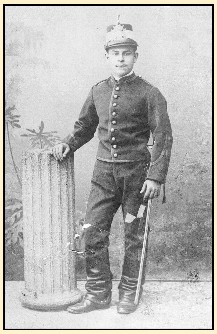
Joyce was aware of this paramilitary force as his notesheets for "Penelope" contain "carabineros" crayoned over in blue. This entry was likely taken from Henry Field's Gibraltar. In his guidebook, Field devotes a paragraph to the "... Carabineros stationed at the lines, whose duty is to keep a sharp look-out ..." The Carabineros appear in Ulysses through the thoughts of Molly Bloom. She recalls that Spain, "with all her carabineros" couldn't keep "4 drunken English sailors" from capturing Gibraltar.
n/ War Office, The Armed Strength of Spain; Luis P. de Ramon, ed., Diccionario Popular Universal (Barcelona: Riera, 1886), s.v. "Cuerpo de Carabineros del Reino;" Jesus N. Nunez, La Absorcion del Cuerpo de Carabineros, series of articles in EuropaSur (2021-2022) collected at jesusnarcisonunezcalvo.blogspot.com; Phillip F. Herring, ed., Joyce's Ulysses Notesheets at the British Museum (Charlottesville: Univ. Press of Virginia, 1972), 511 at line 46; Field, Gibraltar, 115; Ulysses (Gabler) 18:755-56.
At ports of entry, Carabineros were the customs inspectors. Elsewhere, the coast and borders with Portugal and France, the Carabineros were charged with intercepting bands of smugglers. This was dangerous work as organized smugglers were armed and often outnumbered the Carabineros detachments. Accordingly, the War Ministry designated certain comandancias as hardship posts. These were Guipuzcoa and Catalonia along the French border; Cadiz, Algeciras, and Malaga along the coast near Gibraltar; and the Mediterranean island of Mallorca. Carabineros assigned to such comandancias were rotated elsewhere every two or three years.
The Hacienda had no problem in filling the Carabineros ranks for as shown in the table below, total remuneration was relatively high for poverty-stricken Spain. Its officers could afford to live a gentlemanly life and the enlisted men had a standard of living similar to that of British Army sergeants.
Annual Remuneration, Pounds Sterling
Rank | Foot Pay | Mounted Pay | Allowances |
Colonel | 304 | Family Quarters | |
Lieutenant-Colonel | 298 | Family Quarters | |
Major | 282 | Family Quarters | |
Captain | 154 | Family Quarters | |
Lieutenant | 116 | Family Quarters | |
Ensign | 103 | Family Quarters | |
Sergeant-Major | 38 | 47 | 1.92 Food * |
Sergeant | 36 | 44 | 1.82 Food * |
Corporal, 1st Class | 35 | 42 | 1.77 Food * |
Corporal, 2nd Class | 33 | 40 | 1.67 Food * |
Private | 30 | 37 | 1.52 Food * |
* Plus family quarters provided for some enlisted men.
The state provided family quarters for all officers. Junior officers and their families lived in barracks; senior officers in houses leased by the Hacienda. Barracks had family quarters for enlisted men but stations did not. Men assigned to small, isolated stations had to rent housing for their families in nearby towns. This posed a hardship as enlisted men did not receive a family allowance and could visit their wife and children only one or two days every two or three weeks. Foot privates and corporals 2nd class with families lived in poverty as their total remuneration was only £31 10s. and £34 13s. respectively. Mounted Carabineros, which included all officers, had to pay for their horses' upkeep; however, they received an annual horse allowance of £18 5s.
Pensions for enlisted men were inadequate and retired carabineros without employment lived a penurious life. Accordingly, enlisted men were receptive to bribes in order to provide for their old age.
n/ War Office, The Armed Strength of Spain; Diccionario Popular Universal; Nunez, La Absorcion del Cuerpo de Carabineros.
Watch Tower, c. 1895
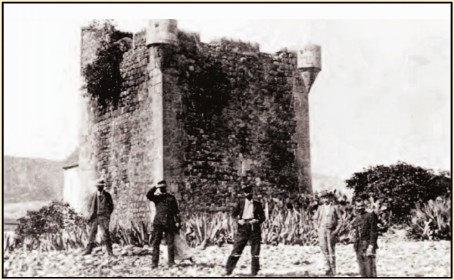
Kiosks, c. 1905

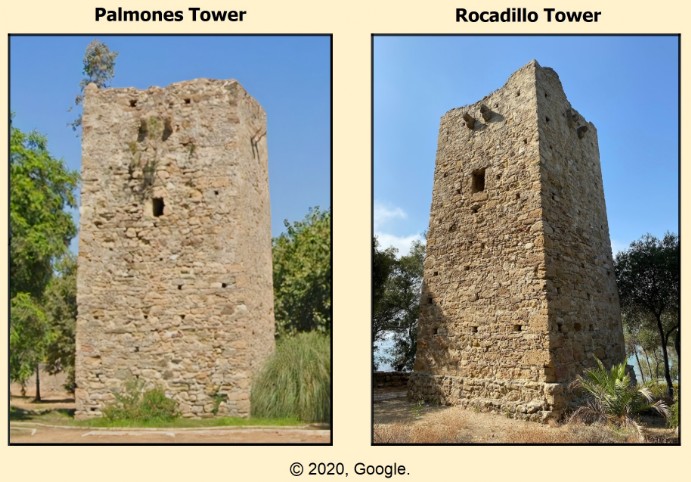
The Guardia Civil
The government formed this paramilitary constabulary in 1844 to replace the militias and "escopoteros" that policed small towns and the countryside. Its primary mission was to suppress banditry on rural roads. In the 1880s, the Guardia Civil was the police force for towns with fewer than 10,000 residents and rural areas. It also sought out deserters from the armed forces and intercepted smugglers who had eluded the Carabineros. In time of war, it was the army's military police.
Originally a component of the Interior Ministry, in 1878 it became part of the army but remained in the Interior Ministry's budget. The Guardia Civil was officered by army lieutenants who had transferred from the infantry or cavalry. Enlisted men were former servicemen with good records or sons of Guardias. Like the Carabineros, the Guardia had matrons who dealt with arrested females. When first organized, literacy was a requirement for recruits; however, as the corps expanded, it was unable to find enough literate ex-servicemen so the government dropped that requirement. The Interior Ministry then established Guardia schools to teach illiterate recruits reading, writing, and arithmetic.
Stationed in the Campo was one company of the Cadiz District, 4th Guardia Civil Tercio (regiment). Guardia Civil districts were equivalent to army battalions and were commanded by lieutenant-colonels. Town Guardias were stationed in small barracks while rural Guardias were stationed in "casas-cuartel" which housed four to six men and their families. In the Gibraltar area, there were Guardia barracks in San Roque and La Linea and a casa-cuartel at Guadarranque. Algeciras had a municipal police force; however, located there was a Guardia port security detachment and a company headquarters.
Guardia Civil, c. 1885
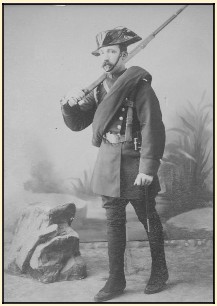
Digitized by the NYPL.
In 1882, the Guardia Civil consisted of 15,536 men, all ranks. The Cadiz comandancia had four foot companies and one mounted squadron. About 45 Guardias were stationed in the vicinity of Gibraltar. Small stations were commanded by a sergeant, larger stations by a lieutenant. Companies and squadrons were commanded by captains who were assisted by a sergeant-major.
Just as enlisted members of the Royal Irish Constabulary could not serve in their home county, Guardia enlisted men could not serve in their home province. When an enlisted member married a local woman, the Guardia transferred him to another province.
Annual Remuneration, Pounds Sterling
Rank | Foot | Mounted | Allowances |
Colonel | 365 | Family Quarters | |
Lieutenant-Colonel | 292 | " | |
Major | 282 | " | |
Captain | 154 | " | |
Lieutenant | 117 | " | |
Ensign | 103 | " | |
Sergeant-Major | 43 | 52 | Family Quarters + 1.5 lbs. Bread Daily |
Sergeant | 42 | 49 | " |
Corporal, 1st Class | 40 | 47 | " |
Corporal, 2nd Class | 38 | 45 | " |
Private, 1st Class | 36 | 44 | " |
Private, 2nd Class | 34 | 42 | " |
All Guardias were given family quarters and enlisted men received daily 1.5 lbs. of bread. Where the Guardia Civil was a town's police force, the municipality had to provide and maintain the barracks or casa-cuartel. As nearly all small towns were poor, Guardia housing there was substandard. Often disused convents and monasteries served as Guardia facilities. Mounted Guardias, which included all officers, had to pay for their horses' upkeep. Like the Carabineros, Guardias received a horse allowance.
Corps members usually spent their entire careers at the same station, with promotion and marriage being the main causes of transfer. Unlike Carabineros, retired Guardias received a pension that afforded them a modest standard of living.
At the time of the "Land War" in Ireland, there was a similar occurence in the Andalucia region of Spain. In the early 1880s, there were numerous violent attacks on landlords and their property in the provinces of Seville, Cadiz (including the Campo de Gibraltar), Cordova, and Huelva. The government blamed the violence on a secret, anarchist organization it labelled "La Mano Negra." In all likelihood, there was no such organized group; however, the government claimed it had 20,000 members. The Andalucian Guardia Civil's primary activity during this period was the suppression of such politically-motivated, agrarian violence.
n/ War Office, The Armed Strength of Spain; Diccionario Popular Universal; Foster Pease Chamberlin, "Honor Bound: The Military Culture of the Civil Guard," PhD Dissertation (San Diego: Univ. of California, 2017).
Partially Restored Guardia Casa-Cuartel

From the website Jaen Escondido at www.jaenescondido.es.
Links to Other Websites
Note: The webpages will open in new windows.
Click on the link to go to that page of the website. Click on the icon to go to the website's home page.
Article by Thomas M. Barker in Armed Forces & Society 10, No. 4 (Summer 1984): 612-22, on JSTOR. Click on the icon on the right to open a free JSTOR account that allows 100 views per month.
Article on the old Spanish fortifications opposing Gibraltar. Baltasar Gomez Nadal, Almoraiama 48 (October 2018): 259-72, in Spanish. The article is in a 3.3 MB pdf that will open from the website of the Instituto de Estudios Campogibraltaranos.
Taken by Luis Carlos Gargallo Martinez. On the website of MonumentalNet, created and maintained by Juan Garcia. Website is in Spanish.
Page on the website of Pablo de Olavide University, Seville. In Spanish.
[ You are at www.majortweedy.com>Molly's Gibraltar>Spanish Army ]
